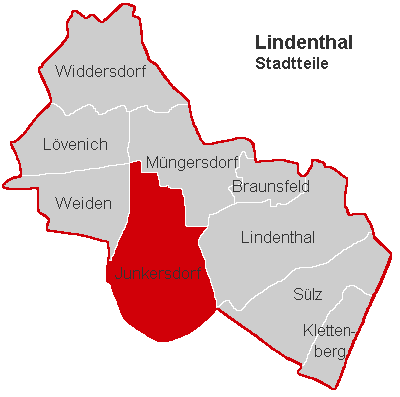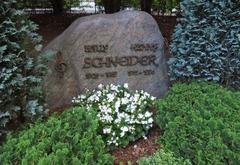
Junkersdorf Cologne Historical Sites: Visiting Hours, Tickets, and Travel Guide
Date: 15/06/2025
Introduction
Situated on the western edge of Cologne, Germany, Junkersdorf is a district where rich medieval history meets contemporary suburban charm. Once a feudal estate for minor nobility, Junkersdorf developed over the centuries from a strategic waypoint on historic trade and pilgrimage routes into a tranquil residential area famous for its preserved architectural heritage, leafy streets, and strong community spirit. Today, it offers a compelling mix of historical sites like the 12th-century St. Pankratius Church, the serene Junkersdorf Chapel, Bauhaus-inspired modernist architecture, and proximity to green spaces such as the Stadtwald (City Forest).
Junkersdorf is open to the public without entrance fees for the district itself, and is easily accessible via Cologne’s extensive public transportation network. Cultural events, seasonal festivals, and culinary experiences—ranging from traditional Rhineland cuisine to contemporary dining at historic venues like Grand Culinas—add to the district’s appeal. This guide outlines visiting hours, ticketing details, travel tips, accessibility, and nearby attractions, helping you make the most of your visit. For the latest updates and guided tours, resources like the Cologne Tourism Official Website, the Cologne Historical Archives, and the Audiala app are invaluable.
Table of Contents
- Introduction
- Historical Overview
- Visiting Junkersdorf
- Cultural Significance and Events
- Photo Opportunities and Guided Tours
- Junkersdorf Chapel: A Historic Monument in Cologne
- Architectural Highlights
- Cultural Life and Community
- Visitor Information: Hours, Tickets, and Tours
- Getting There and Around
- Accessibility
- Best Times to Visit
- Local Etiquette
- Safety and Services
- Exploring Junkersdorf: Residential Life and Lifestyle
- Frequently Asked Questions (FAQ)
- Conclusion
- References
Historical Overview
Early Origins and Medieval Development
Junkersdorf’s origins trace back to the early Middle Ages. The name, derived from “Junker” (young nobleman), points to its beginnings as a feudal estate. First documented between the 10th and 12th centuries, the village benefited from its location near the powerful Archbishopric of Cologne and along major trade and pilgrimage routes. This strategic setting encouraged growth and positioned Junkersdorf as a waypoint for merchants and travelers heading to Cologne (Cologne Tourism Official Website).
Junkersdorf in the Early Modern Period
By the 16th century, Junkersdorf was a modest rural community. Its history is marked by the tragic Junkersdorf Massacre during the Cologne War (1583–1588), when, on July 3, 1586, soldiers loyal to Archbishop-Elector Ernest of Bavaria ambushed a group of civilians, resulting in over 100 deaths (Wikipedia: Junkersdorf massacre). This event remains one of the most notorious civilian massacres of the time and is well-documented in the Cologne Historical Archives.
Visiting Junkersdorf
Visiting Hours and Ticket Information
- District Access: Junkersdorf is open to the public at all times, with no entrance fees.
- Sites and Museums: Some historical sites and museums in and around Junkersdorf may have specific visiting hours and ticket requirements. Always check individual venue websites for the latest details.
Travel Tips and Accessibility
- Public Transport: Junkersdorf is well-served by Cologne’s trams and buses, with stops along Aachener Straße and other key routes.
- Accessibility: The district is pedestrian-friendly and offers accessible routes for visitors with mobility needs.
- Driving and Parking: Limited parking is available; public transport is recommended during busy periods.
- Cycling: Dedicated bike paths connect Junkersdorf to neighboring districts and the city’s greenbelt.
Nearby Attractions
- Cologne Cathedral (Kölner Dom): A UNESCO World Heritage Site.
- Cologne City Museum: Discover the city’s multifaceted history.
- Stadtwald (City Forest): Expansive parkland ideal for walking, jogging, or cycling.
- Local Markets and Dining: Sample traditional Rhineland cuisine and cosmopolitan fare.
Cultural Significance and Events
Junkersdorf hosts various cultural events such as the St. Pankratius parish fair, Cologne Carnival parades, and seasonal festivals. These events highlight local traditions and provide opportunities to engage with the community (Cologne Carnival).
Photo Opportunities and Guided Tours
Scenic streets, historic architecture, and green spaces offer excellent opportunities for photography. Guided walking tours, available through local operators, delve into the district’s history, architecture, and culture. Advance booking is recommended, especially during peak seasons (Cologne Tourism).
Junkersdorf Chapel: A Historic Monument in Cologne
Historical Significance
The Junkersdorf Chapel (Kapelle Junkersdorf) is a cherished religious and community landmark, exemplifying traditional ecclesiastical architecture with features like pitched roofs, timber framing, and stucco facades. It has served as a spiritual center since the early modern period.
Visiting Hours and Admission
- Hours: Open daily from 9:00 AM to 6:00 PM; extended during special events.
- Admission: Free for all visitors.
- Guided Tours: Available on weekends and by appointment.
How to Get There
- Public Transport: Bus lines serve the Junkersdorf district, with stops within walking distance of the chapel.
- By Car: Easy access from A1/A4 autobahns; parking available nearby.
Architectural Features
The chapel blends original timber framing and traditional roofing with modern restoration touches like sustainable materials and energy-efficient technologies. Inside, visitors will find preserved stained glass and wooden pews, creating a peaceful atmosphere.
Visitor Amenities and Accessibility
- Information: Plaques and brochures provide historical context.
- Accessibility: The chapel is wheelchair accessible, with ramps and smooth pathways.
- Photography: Permitted, except during services and events.
Events and Community Engagement
The chapel hosts religious services, seasonal festivals, concerts, and community markets, offering unique ways for visitors to experience local traditions.
Nearby Attractions
- Stadtwald (City Forest): Ideal for outdoor activities.
- Local Cafés and Bakeries: Enjoy refreshments and the district’s welcoming ambiance.
Architectural Highlights
Historic Village Core
Junkersdorf’s core preserves its Rhenish village layout, with winding lanes and a central square. Half-timbered farmhouses and manor houses display classic Rhineland architecture.
St. Pankratius Church
This 12th-century church is a focal point, featuring Romanesque and Gothic elements, medieval and modern stained glass, and a Baroque altar.
- Visiting Hours: Monday–Saturday, 9:00 AM–6:00 PM; Sunday services at 10:00 AM.
- Entry: Free; tickets may be required for concerts or special events (Cologne Churches).
Modernist and Contemporary Residences
Notable Bauhaus-influenced homes from the 1920s–1930s and modern eco-friendly developments are found throughout the district, reinforcing Junkersdorf’s reputation for architectural innovation (Urban Wanders).
Public Spaces and Green Architecture
Junkersdorf prioritizes green spaces and pedestrian areas. The district’s parks, playgrounds, and recent sustainable landscaping projects align with Cologne’s environmental goals (Cologne City Map).
Cultural Life and Community
Local Festivals and Traditions
Annual events such as the St. Pankratius parish fair and Cologne Carnival bring the community together and showcase regional customs.
Art and Public Installations
Though there are no major museums in Junkersdorf, public art installations and murals enhance parks and public spaces. Cologne’s central museums are easily accessible (Cologne Museums).
Culinary Scene
Dining ranges from traditional German restaurants to modern bistros. The historic Grand Culinas restaurant, set in an 18th-century estate, offers themed events and seasonal menus (culinas.de).
Visitor Information: Hours, Tickets, and Tours
- St. Pankratius Church: Open Monday–Saturday, 9:00 AM–6:00 PM; Sunday services at 10:00 AM. Entry is free; ticket required for some events.
- Parks and Green Spaces: Open daily, dawn to dusk; free access.
- Guided Tours: Available through local operators; advance booking recommended (Cologne Tourism).
Getting There and Around
- Public Transport: Tram and bus connections via Aachener Straße.
- By Car: Accessible from A1/A4; parking is limited during events.
- Cycling: Extensive bike paths make cycling a convenient option (Cologne Mobility).
Accessibility
Most public areas and new developments are wheelchair accessible, though some historic buildings may have limitations (Cologne Barrier-Free).
Best Times to Visit
Spring and early summer (May–June) offer mild weather and vibrant gardens. Autumn is quieter, with colorful foliage. Winter brings festive decorations and events (Urban Wanders: Best Time to Visit).
Local Etiquette
Respect the district’s residential character—keep noise levels low and be discreet when photographing private homes. Engaging with locals at community events enhances the experience.
Safety and Services
Junkersdorf is a safe neighborhood with essential services, including pharmacies, clinics, and supermarkets. Major hospitals are nearby in Lindenthal and Ehrenfeld (Cologne Tourist Information).
Exploring Junkersdorf: Residential Life and Lifestyle
Junkersdorf, officially Quarter 306 in Cologne’s District Three, is characterized by a mix of historical estates, Bauhaus-style homes, and modern apartments, surrounded by green spaces. The establishment of the Outer Cologne Green Belt in the 1930s transformed former farmland into a prime residential area (de.wikipedia). The neighborhood’s safe environment, excellent schools, and community amenities make it attractive for families and retirees.
Dining and Leisure
The Grand Culinas restaurant offers Mediterranean, Alpine, German, and Italian cuisine in a historic setting (culinas.de). Outdoor terraces are especially popular in warmer months.
Events and Activities
Community events often take place through churches, schools, and clubs. Cologne’s city-wide festivals, such as the Carnival and Christmas markets, are easily accessible (mygermanyvacation.com).
Frequently Asked Questions (FAQ)
Q: Do I need tickets to visit Junkersdorf?
A: No tickets are required for general exploration; some events or guided tours may require booking.
Q: What are the main historical sites in Junkersdorf?
A: St. Pankratius Church and the Junkersdorf Chapel are key landmarks.
Q: Is Junkersdorf accessible for visitors with disabilities?
A: Yes, most public areas are wheelchair accessible, though some historic sites may have limitations.
Q: Are guided tours available?
A: Yes, local operators offer historical and architectural tours; booking in advance is recommended.
Q: Is Junkersdorf family-friendly?
A: The neighborhood is very family-friendly, with parks, schools, and a safe environment.
Conclusion
Junkersdorf stands out as a unique destination within Cologne, offering a rich tapestry of historical significance, architectural beauty, and vibrant community life. With its medieval roots, preserved landmarks like St. Pankratius Church and the Junkersdorf Chapel, green public spaces, and accessible amenities, it is ideal for self-guided exploration or organized tours. Seasonal festivals, historical walks, and the local culinary scene contribute to a memorable visit.
To enhance your experience, use digital resources such as the Audiala app for guided audio tours and real-time updates. For further insight, consult the Cologne Tourism Official Website and explore additional articles about Cologne’s cultural landscape. Discover Junkersdorf—a peaceful yet culturally rich district that is both a historic gem and a welcoming community.
References and Further Reading
- Exploring Junkersdorf: History, Visiting Hours, and Attractions in Cologne, 2025, Cologne Tourism (Cologne Tourism Official Website)
- Visiting the Junkersdorf Chapel (Kapelle Junkersdorf): A Historic Landmark in Cologne, 2025, Cologne Tourism (Cologne Tourism Official Website)
- Exploring Junkersdorf: Visiting Hours, Tickets, and Cologne’s Historical Gem, 2025, Urban Wanders (Urban Wanders)
- Exploring Junkersdorf: A Guide to Cologne’s Historic Residential Quarter and Lifestyle, 2025, Wikipedia & Culinas (Wikipedia), (culinas.de)
- Junkersdorf massacre, 2025, Wikipedia (Wikipedia: Junkersdorf massacre)
- Cologne Historical Archives, 2025 (Cologne Historical Archives)
- Cologne Carnival (Cologne Carnival)
- Cologne Barrier-Free (Cologne Barrier-Free)
- Cologne Museums (Cologne Museums)
- Cologne Mobility (Cologne Mobility)
- Urban Wanders: Best Time to Visit (Urban Wanders: Best Time to Visit)
- mygermanyvacation.com (mygermanyvacation.com)
- allevents.in (allevents.in)






































































